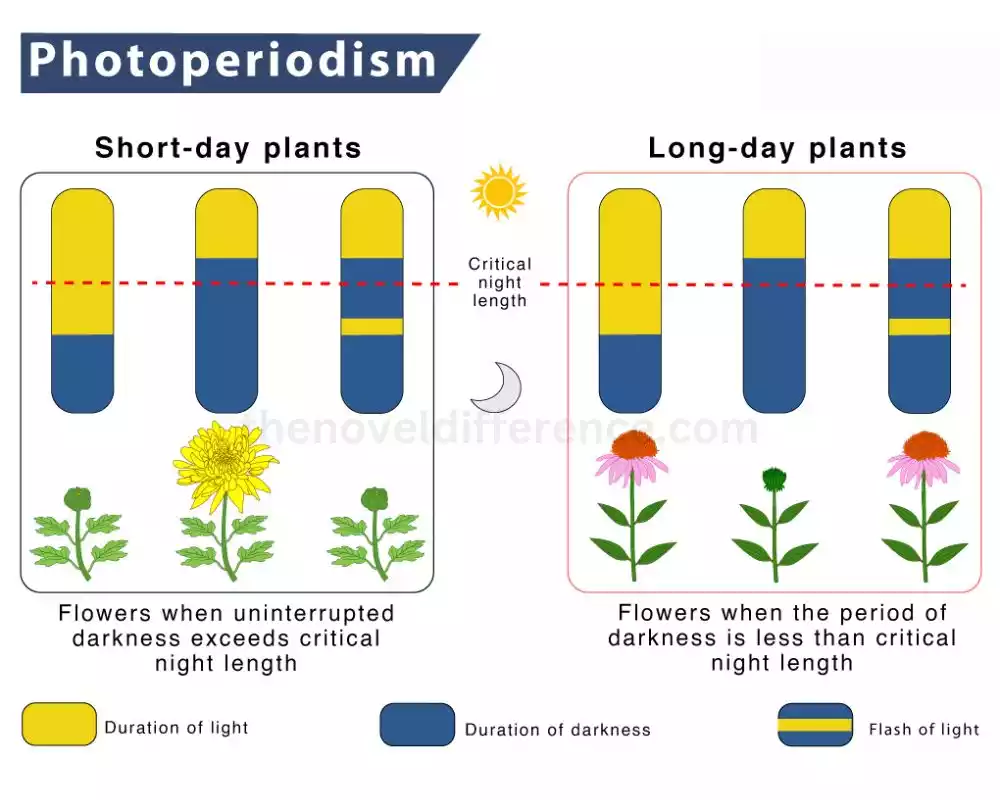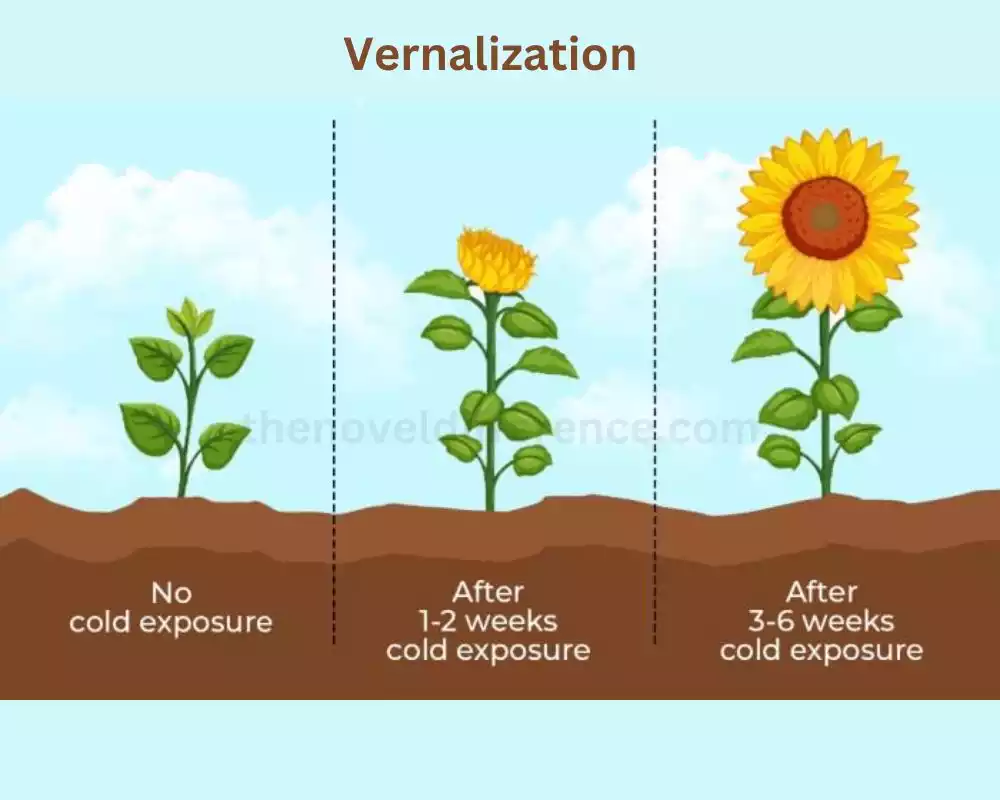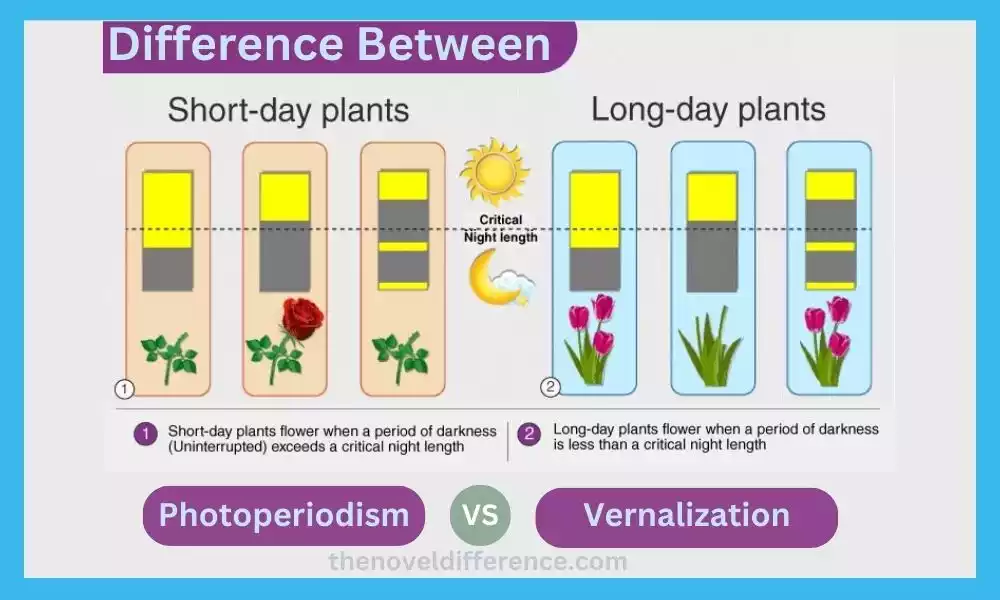Plants are fascinating organisms that exhibit remarkable adaptations to environmental cues. Among the various factors influencing plant growth and development, photoperiodism and vernalization play crucial roles. We will delve into the differences between photoperiodism and vernalization, exploring their mechanisms, effects, and significance in plant biology. Let’s embark on this enlightening journey to unravel the mysteries behind these two processes.
Definition of Photoperiodism and Vernalization
Photoperiodism: Photoperiodism refers to the physiological response of plants to the duration of light and darkness in 24 hours. It is a crucial factor in regulating various developmental processes in plants, such as flowering, dormancy induction, and vegetative growth. Photoperiodic responses differ among plant species, with some requiring specific day lengths to initiate flowering or other developmental changes.
Vernalization: Vernalization is a process in which the exposure of plants to a period of cold temperature (usually during winter) leads to the induction of specific developmental changes, particularly in the transition from vegetative growth to reproductive growth. It is an important adaptation for plants that enables them to synchronize their flowering with favorable environmental conditions in the following growing season. Vernalization helps plants overcome the requirement for prolonged exposure to cold before they can flower or set seed.
Importance of understanding the differences between photoperiodism and vernalization
Understanding the differences between photoperiodism and vernalization is crucial for several reasons:
1. Crop production and agriculture: Knowledge of photoperiodic and vernalization requirements is essential for optimizing crop production. Different crops have specific photoperiodic and vernalization responses that need to be understood to ensure proper timing of planting, flowering, and harvest. Farmers can use this information to manipulate growing conditions and maximize yield.
2. Horticulture and ornamental plants: Understanding photoperiodism and vernalization is essential in horticulture for producing desired flowering patterns and managing plant growth. It helps determine the appropriate light conditions and temperature treatments necessary to induce flowering or control dormancy. This knowledge is particularly important for greenhouse cultivation and the production of ornamental plants.
3. Plant breeding and selection: Plant breeders utilize knowledge of photoperiodic and vernalization requirements to develop new cultivars with desired traits. By manipulating these factors, breeders can select early or late flowering varieties, adapt crops to specific geographical regions, or create crops with improved productivity and adaptability.
4. Climate change and adaptation: Understanding the differences between photoperiodism and vernalization is important in the context of climate change. Shifts in seasonal patterns and altered environmental conditions can impact the photoperiodic and vernalization responses of plants. Studying these reactions can offer assistance foresee and overseeing the impacts of climate alter on plant development, improvement, and blossoming.
5. Fundamental plant biology: Photoperiodism and vernalization are fascinating processes that provide insights into the molecular and genetic mechanisms underlying plant development and adaptation. By studying these forms, researchers can pick up a more profound understanding of how plants see and react to natural prompts, unraveling the complexities of plant physiology and quality control.
Understanding the differences between photoperiodism and vernalization enables researchers, farmers, and horticulturists to manipulate plant growth and development, optimize crop production, and contribute to sustainable agriculture and plant breeding efforts. It also contributes to our broader understanding of plant biology and adaptation to changing environments.
What is Photoperiodism?
Photoperiodism is a physiological response exhibited by plants about the duration of light and darkness in 24 hours, known as the photoperiod. It is a critical factor that influences various developmental processes in plants, including flowering, dormancy induction, and vegetative growth.
Plants have photoreceptors, such as phytochromes, that identify and see changes in light quality and amount. These photoreceptors are mindful of interpreting the photoperiodic signals into biochemical and physiological reactions inside the plant.
Based on their specific photoperiodic requirements, plants can be classified into three categories:
1. Short-day (long-night) plants: These plants initiate flowering or other developmental changes when exposed to a photoperiod shorter than a critical threshold. They typically require longer nights and shorter days to induce flowering. Cases of short-day plants incorporate chrysanthemums, poinsettias, and soybeans.
2. Long-day (short-night) plants: Long-day plants require a photoperiod longer than a critical threshold to trigger flowering. These plants typically flower when exposed to longer days and shorter nights. Common examples of long-day plants include lettuce, spinach, and carnations.
3. Day-neutral plants: Day-neutral plants are not significantly influenced by the duration of light and darkness. They can flower regardless of the photoperiod and rely on other factors such as age or environmental cues to initiate flowering. Examples of day-neutral plants include tomatoes, peppers, and roses.
The precise mechanisms underlying photoperiodism involve intricate molecular pathways and gene regulation. Phytochromes and other photoreceptors perceive the light signals and trigger downstream events that lead to changes in gene expression, hormonal signaling, and ultimately the developmental responses observed in plants.

Understanding photoperiodism is basic for trim generation, cultivation, and plant breeding. It enables farmers and growers to manipulate light conditions to control flowering, optimize yield, and synchronize crop production. Additionally, it contributes to our broader understanding of how plants perceive and respond to environmental cues, highlighting the intricate relationship between plants and their surrounding light conditions.
The Role of light duration in plant growth and Development
Light duration plays a crucial role in the growth and development of plants. The photoperiod, which is the period of light and obscurity in a 24-hour cycle, impacts different physiological and formative forms in plants.
Here are some key roles of light duration in plant growth and development:
1. Flowering: The photoperiod is a significant factor in regulating the timing of flowering in many plant species. It determines whether a plant will flower as a short-day plant, long-day plant, or day-neutral plant. Short-day plants regularly bloom when the evenings are longer than a basic edge, whereas long-day plants bloom when the days are longer than a basic edge. Day-neutral plants are less influenced by photoperiod and can flower regardless of day length.
2. Vegetative growth and dormancy: Light duration affects vegetative growth and the induction of dormancy in certain plants. For example, in some perennial plants, shorter day lengths and longer nights signal the approach of winter, leading to the initiation of dormancy and preparation for winter survival. On the other hand, longer day lengths and shorter nights can promote vegetative growth and inhibit dormancy.
3. Leaf expansion and orientation: Light duration influences leaf expansion and orientation in plants. Some plants exhibit nyctinastic movements, where their leaves open or close depending on the presence or absence of light. The duration of light exposure affects the timing and extent of leaf movement, which can impact overall plant growth and light capture efficiency.
4. Photosynthesis: Light duration is essential for photosynthesis, the process through which plants convert light energy into chemical energy. Longer introduction to light permits plants to capture and utilize more light vitality for photosynthesis, which is basic for creating carbohydrates and supporting plant development.
5. Hormonal regulation: Light duration influences the production and distribution of plant hormones, such as auxins, cytokinins, and gibberellins. These hormones control different angles of plant development and advancement, counting cell prolongation, branching, and flowering. The photoperiod can affect hormone biosynthesis, transport, and signaling pathways, thereby influencing plant morphology and physiology.
6. Circadian rhythm: Light duration is a key entrainment cue for the plant’s internal circadian clock. The circadian rhythm regulates various physiological and biochemical processes within plants, including gene expression, hormone regulation, and metabolic activities. Proper synchronization of the circadian clock with the external light-dark cycle is important for optimal plant growth and development.
Understanding the role of light duration in plant growth and development is crucial for managing crop production, optimizing growth conditions, and manipulating flowering patterns. It permits ranchers, horticulturists, and analysts to control light conditions to control and upgrade plant development, make strides to trim surrender and optimize the timing of different formative forms.
What is Vernalization?
Vernalization is a process in which plants undergo a period of exposure to cold temperatures, typically during winter, that leads to the induction of specific developmental changes. It is a crucial adaptation that enables plants to transition from vegetative growth to reproductive growth when favorable environmental conditions become available in the following growing season.
The vernalization process involves a period of prolonged cold exposure that triggers physiological and molecular changes within the plant. These changes can include the promotion of flowering, bud development, and the breaking of dormancy. Vernalization is particularly important for certain plant species, including winter cereals and biennial plants.
Key aspects of vernalization include:
1. Cold temperature requirement: Vernalization specifically requires exposure to cold temperatures for a certain duration. The specific temperature and duration needed for vernalization vary among plant species and even cultivars within a species. Temperatures around 10 degrees Celsius (32 to 50 degrees Fahrenheit) for a few weeks to months are essential for vernalization to happen.
2. Induction of flowering: Vernalization is commonly associated with the promotion of flowering. In some plant species, cold exposure acts as a trigger that allows the plants to transition from the vegetative phase to the reproductive phase. Without vernalization, these plants may remain in a prolonged vegetative state.
3. Hormonal and genetic regulation: Vernalization involves complex hormonal and genetic mechanisms. During cold exposure, specific genes associated with vernalization are activated, leading to changes in gene expression and subsequent physiological responses. Epigenetic adjustments, such as DNA methylation, can moreover play a part in the control of vernalization-related qualities.
4. Irreversible and reversible responses: Vernalization responses can be irreversible or reversible, depending on the plant species and specific traits. For example, once a plant has undergone vernalization and acquired the ability to flower, this response is typically irreversible. However, other vernalization-related changes, such as dormancy breaking, can be reversible if the plants are exposed to warm temperatures again.
5. Adaptation and survival: Vernalization is an adaptation that allows plants to synchronize their reproductive phase with the optimal growing conditions of the upcoming season. It ensures that flowering and seed production occur during favorable environmental conditions, increasing the chances of successful reproduction and survival.

Understanding vernalization is important for agricultural practices, especially for crops that require vernalization to initiate flowering or break dormancy. It enables farmers and researchers to manipulate growing conditions, including temperature treatments, to synchronize plant growth and optimize crop yield.
Requirements and duration of vernalization
The requirements and duration of vernalization can vary depending on the plant species and even specific cultivars within a species.
Here are some key factors to consider regarding the requirements and duration of vernalization:
1. Temperature: Vernalization specifically involves exposure to cold temperatures. The specific temperature range required for vernalization varies among plant species. Temperatures around 10 degrees Celsius (32 to 50 degrees Fahrenheit) are considered reasonable for actuating vernalization. Some plants may have specific temperature preferences within this range.
2. Duration: The duration of vernalization required for different plants can vary significantly. A few plants may require as it were a couple of weeks of cold introduction, whereas others may require a few months. The necessary duration of vernalization is often influenced by genetic factors and the specific vernalization requirements of the plant species or cultivar.
3. Cold Stratification: Cold stratification is necessary to break seed dormancy and induce germination. Cold stratification involves exposing seeds to cold temperatures for a specific period, mimicking natural winter conditions. This cold treatment helps to overcome seed dormancy mechanisms and promotes germination.
4. Chill Hours: Some plants, particularly fruit trees, require a specific number of chill hours to initiate proper bud development and subsequent flowering. Chill hours refer to the accumulated number of hours below a certain temperature threshold during the dormant period. These chill hours vary among different fruit tree varieties and are necessary to break dormancy and stimulate growth in the subsequent growing season.
5. Genetic Variability: The requirements and duration of vernalization can also vary within a plant species or cultivar due to genetic variability. Different cultivars within a species may have specific vernalization requirements, and plant breeding efforts often aim to develop cultivars with varied vernalization needs to ensure adaptation to different environments.
It is imperative to note that whereas vernalization may be a common wonder in numerous plant species, not all plants require vernalization for legitimate blooming or advancement. Some plant species are classified as day-neutral or do not have significant vernalization requirements. Understanding the specific vernalization requirements of the plants you are working with is crucial for successful cultivation and management.
Determining the optimal requirements and duration of vernalization for a particular plant species or cultivar often involves a combination of scientific research, experimentation, and observation.
Differences between Photoperiodism and Vernalization
Photoperiodism and vernalization are two distinct processes in plant physiology that play essential roles in regulating plant growth and development.
Here are the key differences between photoperiodism and vernalization:
1. Definition and Environmental Factors:
• Photoperiodism: Photoperiodism alludes to the physiological reaction of plants to the length of light and haziness in 24 hours. It is influenced by light intensity and duration.
• Vernalization: Vernalization, on the other hand, is the induction of specific developmental changes in response to exposure to prolonged cold temperatures, usually during winter.
2. Timing of Responses:
• Photoperiodism: Photoperiodic responses occur before flowering or dormancy induction. They determine the timing of various developmental events, such as flowering or vegetative growth.
• Vernalization: Vernalization responses occur during or after winter. The exposure to cold triggers changes that prepare the plant for subsequent flowering or bud development in the following growing season.
3. Duration and Reversibility:
• Photoperiodism: Photoperiodic responses can be temporary or reversible. Plants can respond to changes in the photoperiod by adjusting their growth and development accordingly.
• Vernalization: Vernalization responses are usually irreversible and long-lasting. Once a plant undergoes vernalization, it acquires the ability to flower or break dormancy, and this response is typically not reversible.
4. Environmental Factors Involved:
• Photoperiodism: Photoperiodism is influenced by the duration and intensity of light. The length of day and night (photoperiod) determines the specific photoperiodic response exhibited by a plant.
• Vernalization: Vernalization is primarily influenced by cold temperature. Exposure to prolonged cold temperatures is necessary for the induction of vernalization responses in plants.
5. Genetic and Molecular Mechanisms:
• Photoperiodism: Photoperiodic responses involve photoreceptors, such as phytochromes, that detect light signals and trigger downstream molecular pathways and gene expression changes.
• Vernalization: Vernalization responses involve specific genes associated with vernalization. These qualities are enacted amid cold presentation, driving changes in quality expression and consequent physiological reactions.

Understanding these differences between photoperiodism and vernalization is essential for managing crop production, optimizing plant growth, and manipulating flowering or dormancy induction in various plant species. It allows for the precise control and synchronization of plant developmental processes, leading to improved agricultural practices and enhanced plant adaptation to changing environments.
Comparison Chart
Here’s a comparison chart highlighting the key differences between photoperiodism and vernalization:
| Photoperiodism | Vernalization |
|---|---|
| Physiological response to the duration of light and darkness in a 24-hour period | Induction of specific developmental changes in response to prolonged cold temperatures |
| Occurs before flowering or dormancy induction | Occurs during or after winter |
| Light intensity and duration | Prolonged cold temperatures |
| Temporary or reversible responses | Long-lasting and typically irreversible responses |
| Light intensity and duration | Prolonged cold temperatures |
| Involves photoreceptors, such as phytochromes, and downstream gene expression changes | Involves specific genes associated with vernalization and changes in gene expression |
| Flowering in response to long or short day lengths | Breaking dormancy and inducing flowering in response to cold temperatures |
| Manipulating light conditions to control flowering or vegetative growth | Manipulating temperature conditions to induce vernalization responses |
| Crop production, the timing of planting and flowering, adaptation to changing seasons | Synchronizing flowering, breaking dormancy, adapting to winter conditions |
This comparison chart provides a concise overview of the key distinctions between photoperiodism and vernalization, highlighting their definitions, timing of responses, environmental factors involved, genetic and molecular mechanisms, examples, and their respective importance in plant physiology and agriculture.
Conclusion
Photoperiodism and Vernalization are vital mechanisms that dictate the timing of flowering and other developmental events in plants. While photoperiodism relies on changes in day length and light quality, vernalization is triggered by exposure to cold temperatures. Understanding the differences between these two processes enhances our knowledge of plant biology and aids in agricultural practices. By harnessing the power of photoperiodism and vernalization, we can unlock the full potential of plants and cultivate bountiful harvests.
